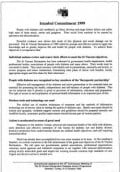- HubPages»
- Food and Cooking»
- Dietary Restrictions»
- Dietary Restrictions for Health
Diabetes Facts: The First Real Dietary Treatment for Diabetes

History of Dietary Treatment for Diabetes
It wasn't until 1796 that the first rational attempt was done at the treatment of diabetes through diet. This was an epoch-making step because it didn't pretend to cure the ailment, but tried to make it possible for the diabetic to live with his disease.
Curiously enough, the advance was created by a military physician, John Rollo, surgeon general of the British Royal Artillery. Though the science of nutrition hadn't yet advanced to the point where carbohydrates, proteins, and the other nutrients were properly acknowledged—let alone classified and understood—the Rollo diet appeared to avoid carbohydrates in favor of proteins. The diet was, said Rollo, "to comprise of animal foods principally."
Despite a lot of shortcomings, the dietary approach unfolded by Rollo raised the curtain on what was to be— till the isolation of insulin—the first efficient method of treating diabetes. Until 1922, when insulin substitute became a new basis for treatment, diet constituted the only valuable approach to diabetes care.
The great majority of diets stressed on deprivation. A few patients were helped by some diets, others were injured. Good or bad, each diet had its eager disciples who asserted that theirs was the only true way and that the others were, at best, mistaken—at worst, a lethal heresy.
At one point, diabetics were made to drink their own urine as a means of replenishing lost sugar. In 1857, P. A. Piorry of France fed his diabetic patients more than a quarter of a pound of candy each day to make up for the loss of sugar through the urine.
Over a period of years, the treatment of diabetics took on the overtones generally associated with the primitive religious ceremony of "mortification of the flesh" as a kind of penance for original sin. Only in this case the sin consisted of being a diabetic.
There could be no question that diet saved numerous lives. This is especially true of the diet developed by F. M. Allen in 1914. The Allen diet involved total limitation of calories and emphasized vegetables cooked in three water changes, bran, and olive oil.
The rigors imposed by such a diet were pathetically exemplified by an emaciated 12-year-old boy, who sneakily ate his toothpaste and the birdseed of his pet canary.
The dawn of the insulin era, which supplied the first original advance in the treatment of diabetes since the Pharaohs, made it possible to free a lot of diabetics from the dietary rigors imposed by earlier treatments. It allowed the use of a higher carbohydrate intake and liberated millions of diabetics from the often ritualized masochism of self-denial. It likewise made possible a longer and more normal life expectancy for the diabetic. But it isn't a cure.
Insulin injections only address a symptom of diabetes. This is the absence or inactivity of the normal insulin we require to help us metabolize sugars. The injected insulin substitutes for the absent insulin or reinforces the inactive insulin, but it doesn't touch the cause of diabetes. Hence, insulin injections are not the perfect solution except in the rare cases where the patient's pancreas is destroyed or was removed by surgery.








